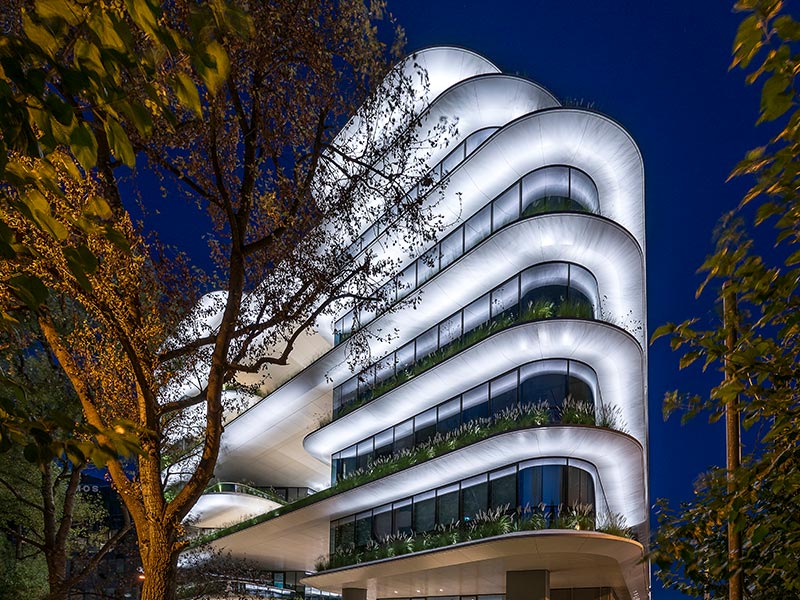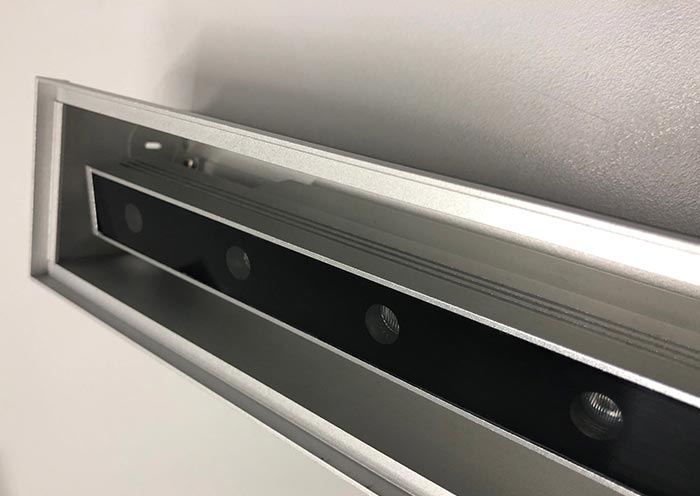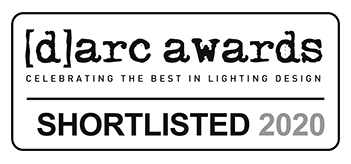

Architectural lighting is a derivative art form.
The illumination must be a celebration of the daylight form, extended into the dusk.
This low-rise building has a strong horizontal language: a striking expressed strata of shading transoms clad in white metal which are elliptical in section - always a challenge in the physics of illumination. The composite aluminium panels are coated in pure white.
Each stratum contains a continuous planter for flowers and other organics that will be partially illuminated and cast complex shadows on the soffit above. Virtual greenery, growing all the while, softening the hard modern lines of the architecture - a fusion of inorganic with organic. Shadow play marionettes that dance slowly in the evening breezes. No two moments will ever be the same.
Fortunately, this challenge of illuminating The Orbit fell to lighting designer Thanos Danilof and his studio DANILOF light + visual perception. He was responsible for a cradle to grave lighting exercise: Concept, Detailed and Final Design & Construction Supervision. The abbreviation DD, for Detailed Design, might be interpreted for this project as Detailed Determination!
Danilof light + visual perception studio were appointed directly by Noval Property. The lighting was designed within the LEED certification framework in collaboration with DCarbon Sustainability Consultants. Danilof Studio also performed the LEED daylight analysis for the building.

illumination Physics began work on the project in December 2018. We are proud to have designed and engineered the custom lighting systems according to the specs of the lighting designer, and supplied the façade lighting for this project in conjunction with our partners in Greece, Luce Ataliotis.
At the very beginning of the project, illumination Physics received a very detailed lighting design concept document together with a full set of drawings from Danilof Studio. Danilof Studio also provided a detailed schedule listing the specification of the lighting equipment’s performance. This included LEDs that were to be binned according to MacAdam Step 2 at 4000K in singular binning. The dimming control of the fixtures must be flicker free when dimming from 100% to zero. The brief made it clear that custom optics would be required to achieve even wash. Anti-glare protection was required for visual comfort and custom housings for the fixtures with adjustable aiming.
So illumination Physics had a clear set of unambiguous instructions before we began our design work to find the best way of following the lighting designers direction.
This was a very good start. Congratulations to the landscape designers Ecoscapes, the LEED consultants DCarbon, the MEP engineers LDK Consultants and construction contractor Terna. Noval property were both the owners of the development and they were project managers and directors of The Orbit project. Accuracy, consistency, subtlety and sustainability. These were the essence of the lighting design with respect to the uplighting of the overhanging transoms. illumination Physics developed special custom fixtures for The Orbit. The main fixture is the IP Linear Series, Linear Graze Mono 6/7.2 W DC/CV – DMX. It is a glare-free light source intended to illuminate the soffit of the expressed transom above, from the deck of the transom feature below, in the majority of the applications. The fixture is small: 25mm wide and 300mm long.

CHALLENGES
Consistency and Binning
There was a constant dialogue with Thanos Danilof and Luce during all of the technical design stages. Effective, inspired and rewarding. illumination Physics co-founding partner, Peter Kemp, and the company’s European Manager, Martin Opolka, conducted the on-site liaison, visiting the site three times with the lighting designer and Luce Ataliotis (Hellas) Ltd – illumination Physics’ partner for Greece and Cyprus. Hong-Kong based co-founding partner, Simon McCartney, conducted all of our factory liaison during the design and testing process. Consistency of the quality of the white light was of paramount importance to Thanos Danilof.
The horizontal strata were to be illuminated from below: curved white surfaces lit in neutral white at 4000K. This created a set of critical parameters requiring extreme level of care in binning. Neutral white is the most sensitive colour temperature to work with, because the slightest variation in colour temperature or hue is obvious and illuminating a perfectly white surface is a sure way to reveal any inconsistencies. illumination Physics as a manufacturer is open to all high-quality LED component suppliers and we use several. However, in our opinion, no LED manufacturer has a perfect product for every application, in our opinion. Manufacturers will emphasise some features in their binning system and not others for advantageous marketing reasons.
For example, illumination Physics use Cree and Osram often, but these companies use different procedures for control of purchase orders and the associated binning. All LED manufacturing produces a disparity of outcomes amongst the following measurable metrics:
- Colour temperature
- Hue
- Brightness
- Colour rendering
- Forward voltage
Osram presents us with choices for all of the relevant metrics concerning the LED specification for any single order. illumination Physics make choices concerning our preferences and tolerances. Osram will then produce a specification that best follows our instructions but most importantly uses only single bin value selections for any metric. This is a very precise way of controlling consistency that is a refinement on the more traditional application of the MacAdam step system for measuring consistency. The majority of luminaire manufacturers use MacAdam step 3 in their specifications. This may be acceptable with RGBW but for The Orbit, in 4000K, only the far more accurate MacAdam step 2 would be acceptable.
For white light architectural lighting and The Orbit, our engineers preferred the Osram product for the following reasons:
CRI
Osram achieves a CRI greater than 90, typically 92. In an RGBW application this may not be important but a higher CRI is an advantage at The Orbit. This was our starting point on Osram’s long list of binning options.
Colour temperature 4000K options
This is where the selection process began. Please refer to the table below:
GW CSHPM1. CM-KULQ-A535-1 & GW CSHPM1. CM-KULQ-XX55-1 are the only specifications for 4000K. So, there were two options at this point.
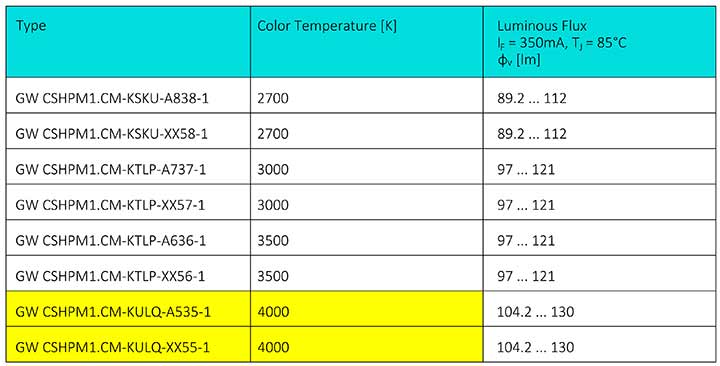
Regardless of the option, only one group will be shipped in any packing unit. This means that there will be no mixing of two groups. Effectively this means single binning. This is applied not only to colour temperature, but to brightness groups, forward voltage and other relevant metrics as well.
Managing colour temperature and chromaticity coordinates
The CIE 1931 diagram showing how colour temperature is plotted. The curve plots the coordinates of white light and the colour temperature is shown in Degrees Kelvin. The values on the edges of the CIE locus are the wavelengths in nanometres.
This diagram plots the colour temperature curve in greater detail showing the binning options available and an enlargement of the zone where 4000K occurs.
The inner circle shows the target value of 35.
The next circle shows 4 other extremely similar values of chromaticity which are inclined towards the cyan, magenta and yellow hues, and so on.
The outer square contains values that are more diverse.
We will only accept E5 or G5. The difference in hue is not significant in itself but it is most important that we receive only one of the above for consistency.
Brightness groups
Osram binning produces 7 brightness groups. The range of performance is significant, and it is desirable to make use of the higher-performing bins. Equally important is the use of only two bins that are closest together in performance, so we will only accept either KT and KU(not both), as these provide above-average performance and yet are the closest in value to each other. (Refer to colour temperature and chromaticity coordinates)

Binning conclusion
The Osram selection of metrics allows us to state a number of preferences and choices. Osram then creates a special-order code that takes account of the best choices of single bin metrics.
For The Orbit, Osram made sense. illumination Physics does not engage in politics when it comes to component choices and we will always use the most suitable LED for the specific needs of the project.
Even illumination – a new family of fixtures
The linear light fixtures that would be used were to be as physically small as possible for aesthetic reasons. They could not be continuous due to the curves and therefore the overlapping beams must be perfectly overlaid to produce a homogenous result.
Because of the constantly varying curvature in the planform of the transom features, a 300 mm long linear light fixture would be best; because it would produce a shorter illuminated footprint, more suitable for focussing on the curved target.
There was a sufficient challenge in plot and focus, but there was another layer of complexity. The projection distance from the luminaires to the illuminated surfaces varies, necessitating a family of custom light fixtures with different lenses and powers.
Although the transom features are all the same, they are not always continuous in plan. Therefore, several projection distances occur, but the visual result of all cases must be identical. The typical distance from the luminaire to the transom feature above is one floor, or 2.6 metres. In other cases, the projection distance was more than double this. In certain cases at ground level, the projection distance was less than one floor (1.6 metres) because the luminaires had to be mounted on objects such as planters. Lastly, in some areas, the luminaire would be mounted in specially designed custom in-ground kits, in situations where this was the only way to achieve the perfect projection position.
This resulted in a new family of linear light fixtures based on a 6 LED, 300 mm version of the illumination Physics Linear Graze Mono, DC, CV, and DMX.
The naming protocol means:
Mono – single colour, single-die LEDs are used
DC – DC voltage made sense. With a 24-volt DC product, the physical dimensions are smaller than an AC voltage fixture with a transformer on board. Importantly, since the wattage of the typical fixture would be only 7.2 watts per fixture, this meant that a chain of a maximum of 15 light fixtures could be powered by one 150 watt PSU. DC was economical.
CV – constant voltage.
DMX – DMX onboard each fixture would be essential because each individual fixture would need to have its own dimming level set to complete the focus. The alternative, DALI, was not suitable because this format has a very slow reaction time.
Controlling the illuminated footprint with different projection distances between the luminaire and the illuminated surface.
The design of the luminaire anticipated the varying projection distances and the consequent requirement of several variants. All needed to be aimable by rotation in the short axis with an adjustable bracket.
Numerous prototypes were made for factory mock-ups. Tests were conducted simulating the precise distances and projection surfaces that we would encounter on-site.
Because the beam of light will diverge over distance and light diminishes with distance, it is necessary to use a narrower, concentrated focus with the luminaires that have the longer projection, so that the illuminated footprint on the soffit on the 2.6 metre projection or 6-metre situation is consistent.
The typical 2.6-metre projection requires a lens with a 20 x 40-degree asymmetric lens – the 20-degree metric being at 90 degrees to the long axis of the linear luminaire. This gives ideal coverage at the lesser distance: 7.2 watts was found to be sufficient.
The 6-metre projection requires a lens with a 10 x 35-degree asymmetric lens – the 10-degree metric being at 90 degrees to the long axis of the linear luminaire. This gives ideal coverage at a greater distance: 10 watts was found to be sufficient.
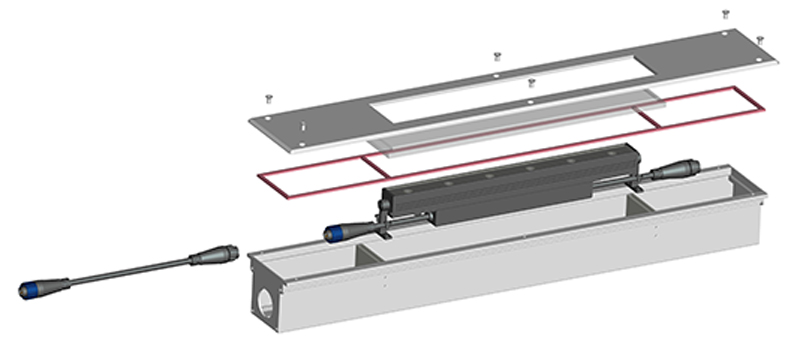
illumination Physics supplied the following samples:
- 8 -pcs IP linear series linear graze mono 6/7.2W 4000K MacAdam 2 with internal egg crate louvre 20x40 deg IP67 24VDC Handmade
- 8 -pcs IP linear series linear graze mono 6/7.2W 4000K Mac Adam 2 with internal egg crate louvre 30x60 deg IP67 24VDC Handmade
- 1 – pcs CNC inground enclosure with a removable glass cover
With these tools available, we successfully conducted the on-site visual mock-up. The luminaires behaved as expected and dimming allowed for the fine adjustment of brightness.
This brought us to the next of Athanassios Danilof’s concerns: the dimming must be flicker-free.
Onboard driver performance
Nowadays, flicker should not be a problem and yet it remains a problem because not all contemporary LED products are the so-called “TV stable version”. Flicker results from the use of slow frequencies being used in the modulation that produces the dimming effect. The flicker is very apparent when viewed through video.
All of our products are TV stable and the frequency used is 7.8 kHz. This is so fast that the IP Linear Graze is fully dimmable and totally flicker-free. Any minor differences in apparent illumination brightness amongst the fixtures can be adjusted in dimming with total confidence.
The fixtures
Following successful testing of the prototypes on-site in Athens, the final lighting specification was resolved into three custom types.
The most typical was 1,398 pieces of the smaller 7.2-watt IP Linear Graze mono fitted with the 20 x 40 lenses. This would be used for the single height projections of 2.6 metres.
A further 14 pieces of the same fixture would be supplied with 30 x 60 lenses to be used in the non-typical situations where the projection distance was only 1.6 metres.
For situations requiring double height projection, we used 27 pieces of the more powerful 10-watt version with 10 x 35 mm lenses.
The fourth variant would be an in-ground light fixture and for this, illumination Physics designed a special in-ground kit that could accommodate the 7.2-watt variant. The kit includes a bracket system that allows rotational aiming of the light fixture. Typical of Thanos Danilof’s attention to detail, the trafficable glass lens cover was non-slip. The ends of the glass cover were blacked out to hide the parts of the light fixture that do not emit light for aesthetics reasons.



Photo © Pygmalion Karatzas
Glare and the illumination of light trespass
Thanos Danilof paid great attention to controlling glare, as well as protecting the tenants and the illumination of stray light; thus, protecting the environment. To this end, egg crate louvres were fitted between the lenses and the inside of the glass lens covers.
Baffles were also provided for particular areas to ensure the sharp cut off of any light that might stray beyond the illuminated surface.
“There were a lot of obstacles during the construction stage, but I think we managed to overcome them and deliver the best possible result”.
- Thanos Danilof.
Addressing
All of illumination Physics’ DMX fixtures use RDM (remote device management) on board. This allows the address of each fixture in a circuit (containing as many as 32 fixtures) to be set by connecting an RDM controller to the beginning of that circuit. For The Orbit, the number of fixtures in a circuit is limited not by the DMX protocol but by voltage drop, and the maximum in series is 15 pieces.
Setting the addresses for 1,408 fixtures on-site at The Orbit would be challenging. To assist Luce, it was decided to set all of the DMX addresses in the factory. Every light fixture would be addressed, tested and labled before shipment to Athens. Every carton would carry the DMX information. DMX addressing information was provided by Luce Ataliotis.

Planning the installation
Working with Luce, illumination Physics helped to plan the wiring design for the project. The layout was determined in large part to the calculation of the voltage drop amongst the fixtures and cables in any circuit. This must include the DC/DMX 5 pin starter cable and any interlinking extension cables.
The control system and data network were designed, supplied and installed by Luce Ataliotis, utilising illumination Physics’ optically isolated DMX splitters. Luce Ataliotis additionally provided the power supplies and electrical and data network, which also employed Illumination Physics’ optically isolated DMX splitters.
The Luce Ataliotis team notably included:
Lefteris Ataliotis – Owner
Nikos Pavlidis – General Manager
George Garyfallos – Sales Manager
Dimitris Kapetanelis – Programmer and control/network designer
“My thanks to all of the illumination Physics and Luce team for the great contribution to this highly successful project”.
- Lefteris Ataliotis.
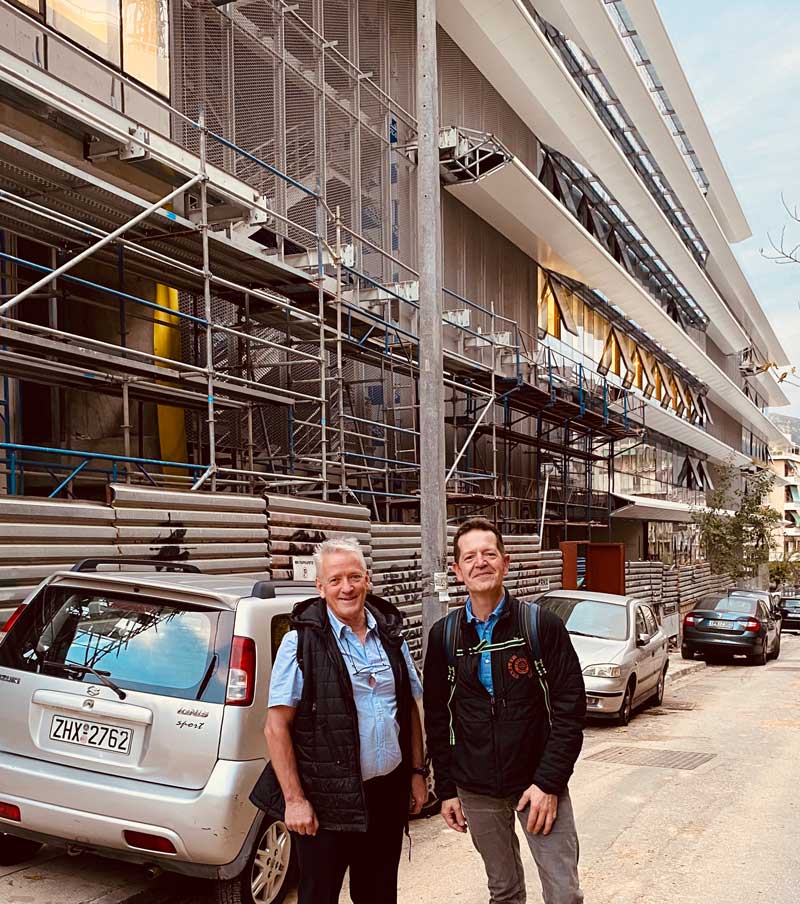
Conclusion
No compromises were made at The Orbit. The lighting design and technical execution were perfectly aligned. The luminaires were quickly created to do exactly what was required of them. The entire team possessed a great will to excel, and through agility, inspiration and a great depth of experience, this complex exercise in pure white lighting was delivered as promised. The Orbit is the freshest new landmark in Athens.
“Dear Lefteris, many thanks for your kind words and congratulations to you too and everyone involved:
Nikos and George in Athens for their consistency and professionalism,
Peter, Martin and their team at illumination Physics in Hong Kong for their agility and precision,
and Dimos of course for his perfectionism and great skills on site”.
- Thanos Danilof
PRODUCTS
- 1,422 x IP linear series 7.2W 4000K Mac Adam 2 with internal egg crate louver 20x40 deg IP67 24VDC
- 24 x Custom inground enclosures with removable glass cover for IP linear series 7.2W 4000K 20x40 deg IP67
- 27 x IP linear series 10W 4000K Mac Adam 2 with internal egg crate louver 10x35 deg IP67 24VDC
- 14 x IP linear series 7.2W 4000K Mac Adam 2 with internal egg crate louver 30x60 deg IP67 24VDC
- 22 x IP DMX/RDM 6 way splitter with optical isolation
- 100 x External visors
- 19 x 10m starter cables
- 90 x 3m starter cables
- 112 x 2m starter cables
- 17 x 1m starter cables
- 5 x 12m extension cables
- 40 x 5m extension cables
- 12 x 1.3m extension cables






